-
 Bitcoin
Bitcoin $116400
-1.69% -
 Ethereum
Ethereum $3731
2.87% -
 XRP
XRP $3.119
-1.00% -
 Tether USDt
Tether USDt $1.000
-0.04% -
 BNB
BNB $774.0
1.01% -
 Solana
Solana $181.0
-2.25% -
 USDC
USDC $1.000
0.02% -
 Dogecoin
Dogecoin $0.2314
-2.16% -
 TRON
TRON $0.3145
1.76% -
 Cardano
Cardano $0.8087
0.22% -
 Hyperliquid
Hyperliquid $43.01
0.68% -
 Stellar
Stellar $0.4247
-0.93% -
 Sui
Sui $3.758
1.42% -
 Chainlink
Chainlink $18.30
1.99% -
 Bitcoin Cash
Bitcoin Cash $551.4
5.66% -
 Hedera
Hedera $0.2482
3.08% -
 Avalanche
Avalanche $23.70
0.18% -
 Litecoin
Litecoin $115.1
2.44% -
 UNUS SED LEO
UNUS SED LEO $8.972
-0.36% -
 Shiba Inu
Shiba Inu $0.00001370
0.73% -
 Toncoin
Toncoin $3.146
0.74% -
 Ethena USDe
Ethena USDe $1.001
-0.03% -
 Uniswap
Uniswap $10.49
3.95% -
 Polkadot
Polkadot $4.044
1.42% -
 Monero
Monero $328.9
2.43% -
 Dai
Dai $0.9998
-0.03% -
 Bitget Token
Bitget Token $4.510
-1.10% -
 Pepe
Pepe $0.00001231
-1.68% -
 Aave
Aave $293.4
2.16% -
 Cronos
Cronos $0.1294
2.89%
How to deal with the monthly RSI overbought fall + weekly MACD top divergence + daily line falling below the 30-day line?
A monthly RSI above 70, weekly MACD top divergence, and daily close below the 30-day MA signal rising correction risk—caution is warranted.
Jul 24, 2025 at 12:01 pm
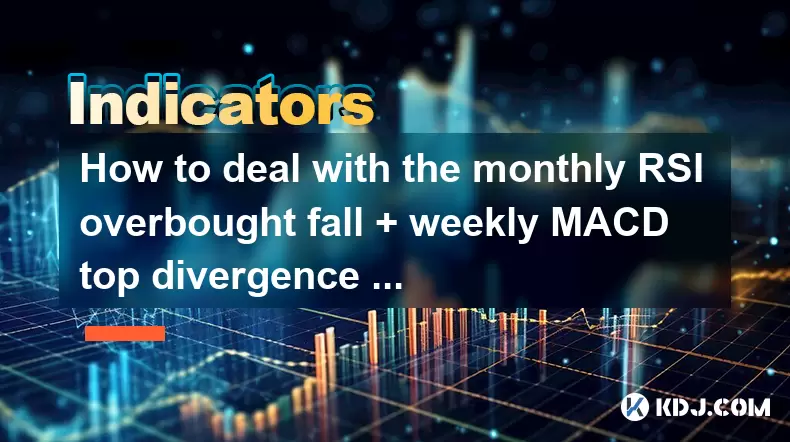
Understanding the Monthly RSI Overbought Signal
When the monthly RSI enters overbought territory, it indicates that the cryptocurrency has experienced strong upward momentum over an extended period. The Relative Strength Index (RSI) is considered overbought when it rises above 70, and on a monthly chart, this suggests sustained bullish pressure. However, an overbought condition does not automatically mean a reversal will occur—it only signals that the asset may be overextended. In the context of long-term trading, a monthly RSI above 70 should be treated as a warning rather than a sell signal. Traders must analyze whether the overbought state is supported by strong fundamentals or driven by speculative hype. If the price continues to rise without correction, the RSI can remain overbought for several months, especially during strong bull runs.
It is crucial to distinguish between a healthy overbought condition and one that precedes a correction. A monthly RSI above 80 is more concerning and often coincides with market euphoria. At this level, profit-taking becomes increasingly likely. Historical data from major cryptocurrencies like Bitcoin and Ethereum shows that prolonged RSI overbought levels on the monthly timeframe have often been followed by significant corrections, especially when combined with other bearish indicators.
Interpreting Weekly MACD Top Divergence
A top divergence on the weekly MACD (Moving Average Convergence Divergence) occurs when the price makes a higher high, but the MACD histogram or signal line forms a lower high. This signals weakening momentum despite rising prices. This kind of divergence is a strong cautionary sign, particularly in the weekly timeframe, which filters out short-term noise and reflects broader market sentiment.
To identify a weekly MACD top divergence:
- Confirm that the price reaches a new peak on the weekly chart.
- Check that the MACD line (blue line) or histogram fails to surpass its previous peak.
- Ensure the divergence forms after a sustained uptrend, increasing its reliability.
When divergence appears, it suggests that buying pressure is diminishing. Even if the price continues to climb, the underlying momentum is fading. This is especially dangerous when combined with overbought conditions on higher timeframes. Traders should monitor for bearish confirmation, such as a MACD crossover below the signal line or a break of key support levels. The presence of weekly divergence does not guarantee an immediate reversal but increases the probability of a correction or consolidation phase.
Analyzing the Daily Price Drop Below the 30-Day Moving Average
The daily closing price falling below the 30-day moving average (MA) is a technical breakdown that shifts short-term sentiment from bullish to neutral or bearish. The 30-day MA acts as dynamic support during uptrends. When price closes beneath it, especially on high volume, it may indicate that short-term traders are losing confidence.
To verify the significance of this drop:
- Check whether the close is below the 30-day MA for two consecutive days, reducing the chance of a false signal.
- Observe trading volume—a spike in volume during the drop strengthens the bearish implication.
- Look at the position of the 30-day MA relative to longer-term MAs (e.g., 50-day or 200-day). If the 30-day MA is above the 200-day MA (golden cross), the overall trend may still be bullish despite the short-term drop.
A break below the 30-day MA can trigger algorithmic sell-offs and stop-loss orders, accelerating downward movement. It also invalidates many short-term trend-following strategies that rely on price holding above this average. For traders using moving averages as entry or exit signals, this development may prompt position reduction or hedging.
Combining the Three Indicators: Risk Assessment Framework
When monthly RSI overbought, weekly MACD top divergence, and daily price below 30-day MA appear together, they form a multi-timeframe bearish confluence. Each indicator operates on a different timeframe, offering a layered view of market health:
- The monthly RSI overbought warns of long-term exhaustion.
- The weekly MACD divergence confirms weakening momentum on an intermediate basis.
- The daily 30-day MA breakdown signals short-term trend deterioration.
This combination increases the likelihood of a meaningful correction. Traders should assess position exposure and consider risk mitigation. Holding large long positions under these conditions becomes increasingly risky. Instead of exiting entirely, traders may:
- Reduce position size to lock in profits.
- Set tighter stop-loss orders below recent swing lows.
- Shift to neutral strategies like range trading or options hedging.
It is essential to avoid emotional reactions. Not every such confluence leads to a crash—some result in sideways consolidation. Monitoring volume, order book depth, and on-chain metrics (e.g., exchange outflows, whale movements) can provide additional context.
Actionable Steps for Traders Facing This Scenario
When encountering this technical setup, traders should follow a structured response:
- Review open positions and calculate risk exposure relative to portfolio size.
- Analyze higher timeframe support levels, such as previous monthly or weekly swing lows.
- Check for bullish reversal patterns on lower timeframes (e.g., daily or 4-hour charts), like double bottoms or bullish engulfing candles.
- Adjust stop-loss orders to protect gains, placing them below key support zones.
- Consider taking partial profits, especially if entry was early in the uptrend.
- Avoid new long entries until at least one bearish signal resolves (e.g., RSI exits overbought, MACD divergence disappears, price reclaims 30-day MA).
- Monitor for bearish continuation patterns, such as lower highs and lower lows, which confirm downtrend development.
Using tools like TradingView, traders can set alerts for RSI levels, MACD crossovers, and moving average breaches to stay informed without constant monitoring. Backtesting similar historical scenarios on assets like BTC/USD or ETH/USD can also improve decision-making under such conditions.
Frequently Asked Questions
Can the price continue rising even with monthly RSI overbought and weekly MACD divergence?
Yes, strong bull markets can sustain overbought RSI and divergence for extended periods. Momentum can persist due to institutional inflows or macroeconomic factors. However, the risk of a sharp correction increases, and position sizing should reflect this elevated risk.
What if the daily price moves back above the 30-day MA after a brief drop?
A quick recovery may indicate the breakdown was a false signal or a shakeout of weak hands. Traders should reassess the strength of the rebound—preferably with rising volume and a return of bullish candle patterns. The bearish confluence weakens if all three signals do not persist.
How reliable is MACD divergence on the weekly chart compared to daily?
Weekly MACD divergence is generally more reliable because it filters out short-term volatility. It reflects structural shifts in momentum and often precedes larger corrections. However, confirmation from price action is still required before taking action.
Should I short the asset when all three conditions are met?
Shorting based solely on technical indicators carries high risk, especially in crypto markets prone to rallies. Instead of aggressive shorting, consider profit-taking, hedging with options, or tightening risk controls. Short entries should be confirmed by additional bearish patterns and volume analysis.
Disclaimer:info@kdj.com
The information provided is not trading advice. kdj.com does not assume any responsibility for any investments made based on the information provided in this article. Cryptocurrencies are highly volatile and it is highly recommended that you invest with caution after thorough research!
If you believe that the content used on this website infringes your copyright, please contact us immediately (info@kdj.com) and we will delete it promptly.
- Pump, Bonk, Buyback: A Wild Ride in Crypto Town!
- 2025-07-25 19:10:12
- Punisher Coin, Dogecoin, Shiba Inu: Meme Coin Mania in the 2025 Crypto Landscape
- 2025-07-25 19:10:12
- Celestia's Token Control: Buyback & Staking Overhaul in Focus
- 2025-07-25 19:50:11
- Altcoins, Bitcoin, and Crypto Coins: What's Hot in the NYC Crypto Scene?
- 2025-07-25 19:55:52
- Litecoin Price Breakout Imminent? Rally Potential Explored!
- 2025-07-25 17:30:12
- Ether ETFs Surge, Bitcoin Wobbles: Is an ETH Breakout Imminent?
- 2025-07-25 16:50:12
Related knowledge

How to interpret that the KDJ D line is downward for a long time but the price is sideways?
Jul 25,2025 at 07:00pm
Understanding the KDJ Indicator and Its ComponentsThe KDJ indicator is a momentum oscillator widely used in cryptocurrency trading to assess overbough...

What does it mean that the KDJ indicator forms a double bottom at a low level?
Jul 25,2025 at 05:08pm
Understanding the KDJ Indicator in Cryptocurrency TradingThe KDJ indicator is a momentum oscillator widely used in cryptocurrency trading to identify ...
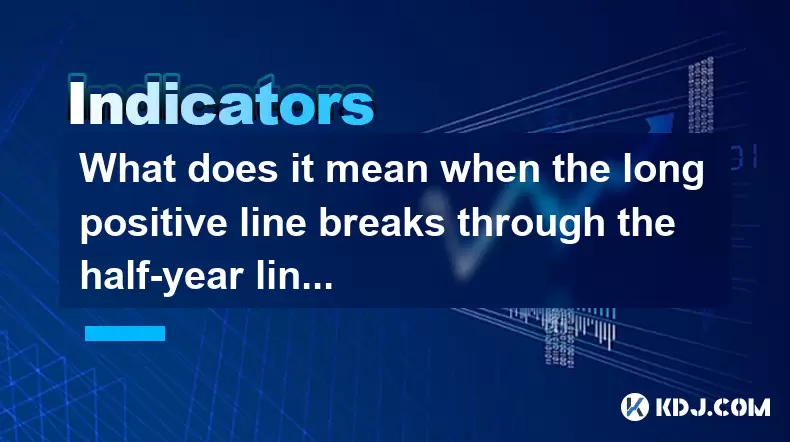
What does it mean when the long positive line breaks through the half-year line and then steps back?
Jul 25,2025 at 06:49pm
Understanding the Long Positive Line in Candlestick ChartsIn the world of cryptocurrency trading, candlestick patterns play a vital role in technical ...
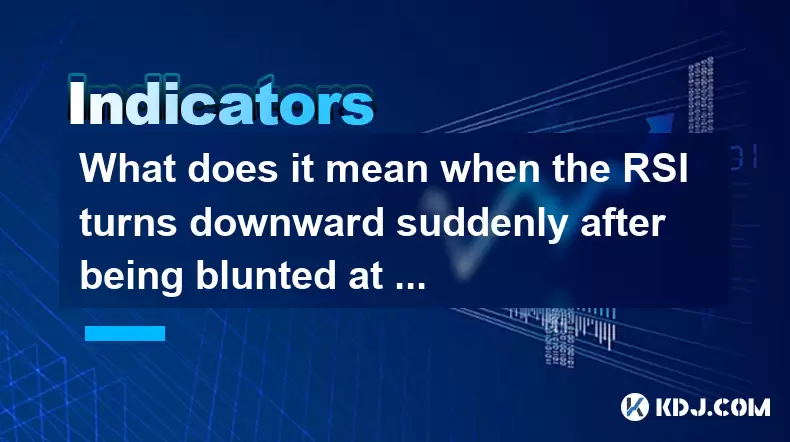
What does it mean when the RSI turns downward suddenly after being blunted at a high level?
Jul 25,2025 at 04:00pm
Understanding the RSI and Its Role in Technical AnalysisThe Relative Strength Index (RSI) is a momentum oscillator that measures the speed and change ...
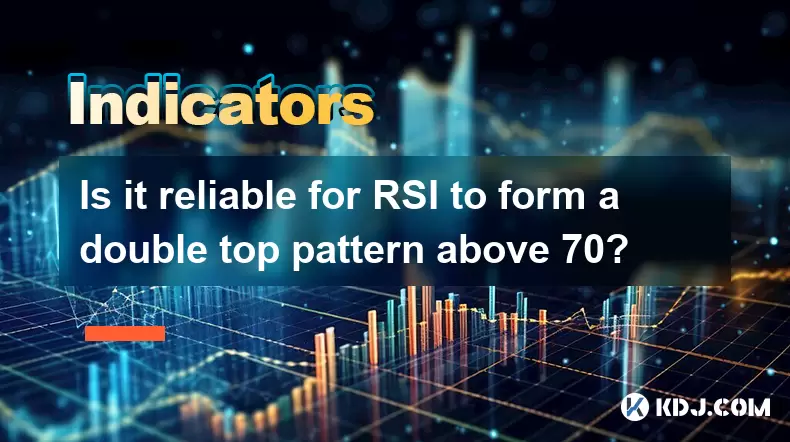
Is it reliable for RSI to form a double top pattern above 70?
Jul 25,2025 at 04:49pm
Understanding the RSI Indicator and Its Role in Technical AnalysisThe Relative Strength Index (RSI) is a momentum oscillator that measures the speed a...
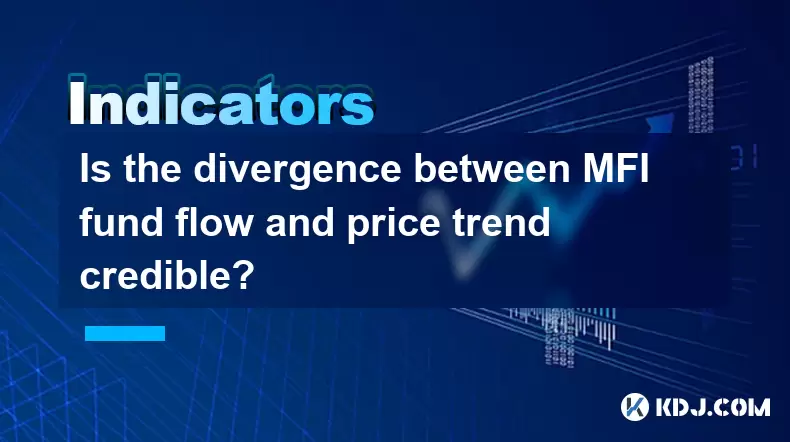
Is the divergence between MFI fund flow and price trend credible?
Jul 25,2025 at 12:01pm
Understanding MFI and Fund Flow in Cryptocurrency MarketsThe Money Flow Index (MFI) is a technical oscillator that combines price and volume to assess...

How to interpret that the KDJ D line is downward for a long time but the price is sideways?
Jul 25,2025 at 07:00pm
Understanding the KDJ Indicator and Its ComponentsThe KDJ indicator is a momentum oscillator widely used in cryptocurrency trading to assess overbough...

What does it mean that the KDJ indicator forms a double bottom at a low level?
Jul 25,2025 at 05:08pm
Understanding the KDJ Indicator in Cryptocurrency TradingThe KDJ indicator is a momentum oscillator widely used in cryptocurrency trading to identify ...

What does it mean when the long positive line breaks through the half-year line and then steps back?
Jul 25,2025 at 06:49pm
Understanding the Long Positive Line in Candlestick ChartsIn the world of cryptocurrency trading, candlestick patterns play a vital role in technical ...

What does it mean when the RSI turns downward suddenly after being blunted at a high level?
Jul 25,2025 at 04:00pm
Understanding the RSI and Its Role in Technical AnalysisThe Relative Strength Index (RSI) is a momentum oscillator that measures the speed and change ...

Is it reliable for RSI to form a double top pattern above 70?
Jul 25,2025 at 04:49pm
Understanding the RSI Indicator and Its Role in Technical AnalysisThe Relative Strength Index (RSI) is a momentum oscillator that measures the speed a...

Is the divergence between MFI fund flow and price trend credible?
Jul 25,2025 at 12:01pm
Understanding MFI and Fund Flow in Cryptocurrency MarketsThe Money Flow Index (MFI) is a technical oscillator that combines price and volume to assess...
See all articles

























































































